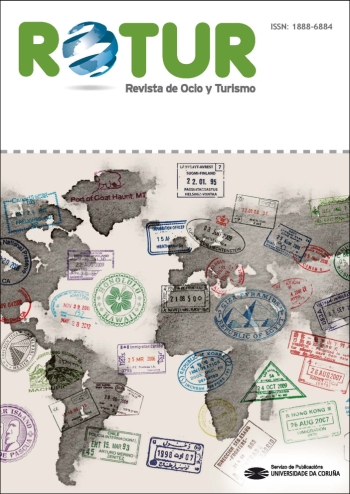Las voces del vino: las narrativas del enoturismo en Calonge, Cataluña
Contenido principal del artículo
Resumen
Calonge es un municipio de Cataluña, España, conocido por sus dos formas de hacer vino: el vino payés, elaborado ancestralmente desde el siglo XIX, y los vinos de las Denominaciones de Origen, con procesos mecanizados y modernos. Estas dos realidades permiten crear diferentes historias a ser contadas a los turistas durante las visitas guiadas a las bodegas de la localidad. Este artículo explora la construcción de estas narrativas durante los tours que ofrecen dos bodegas, una inscrita en la Denominación de Origen y otra no. Se describen y comparan los elementos presentes en la dinámica entre turistas y guías de bodega. Se realiza un estudio etnográfico en donde las narraciones, entrevistas, observaciones y notas de campo se analizan a través de la teoría de la performance. La investigación apunta en la dirección de que las narrativas presentan una estructura similar, conteniendo cinco ejes principales. Además, revela que el enoturismo asume múltiples voces y que las visitas guiadas podrían servir tanto como herramienta de venta y marketing como asumir un papel de resistencia y transformación social en búsqueda de la preservación del patrimonio cultural de Calonge.
Palabras clave:
Descargas
Métricas
Detalles del artículo
Citas
Adler, Judith (1989). Travel as performed art. American Journal of Sociology, 94(6), 1366–1391. http://www.jstor.org/stable/2780963
Arellano, Alexandra (2004). Bodies, spirits, and incas: Performing Machu Pichu. In M. Sheller & J. Urry (Eds.), Tourism mobilities: Places to play, places in play, 67–78. London: Routledge
Aulet Serrallonga, Silvia (2011). El guía como agente de comunicación turística. Manual de Comunicación Turística, 263-273.
Balda Manzanos, Pedro José y Martinez de Toda, Fernando (2020). Informe final: variedades minoritarias en Calonge. Universidad de La Rioja.
Bauman, Richard (1975). Verbal art as performance 1. American anthropologist, 77(2), 290-311. http://www.jstor.org/stable/674535
Bauman, Richard, and Charles Briggs (2006). Poética e Performance como perspectivas críticas sobre a linguagem e a vida social. Ilha Revista de Antropologia, 8(1), 2, 185-229. https://periodicos.ufsc.br/index.php/ilha/article/view/18230
Bauman, Richard, and Joel Sherzer (1975). The ethnography of speaking. Annual review of anthropology. The Ethnography of Speaking, 4, 95-119. https://doi.org/10.1146/annurev.an.04.100175.000523
Belk, Russell W., John F. Sherry Jr, and Melanie Wallendorf (1988). A naturalistic inquiry into buyer and seller behavior at a swap meet. Journal of Consumer Research, 14(4), 449–470. http://www.jstor.org/stable/2489153
Crang, Mike (1997). Picturing practices: Research through the tourist gaze. Progress in Human Geography, 21(3), 359–373. https://doi.org/10.1191/030913297669603510
Desmond, Jane (1999). Introduction: Cultural bodies: Hawaiian tourism and performance. In J. Desmond (Ed.), Staging tourism: Bodies on display from Waikiki to sea world, 2–9. Chicago, IL: University of Chicago Press.
Díaz Armas, Ricardo (2008). Potencialidad e integración del" turismo del vino" en un destino de sol y playa: el caso de Tenerife. PASOS. Revista de turismo y patrimonio cultural, 6(2), 199-212. https://doi.org/10.25145/j.pasos.2008.06.016
Edensor, Tim (2000). Staging tourism: Tourists as performers. Annals of Tourism Research, 27(2), 322–344. https://doi.org/10.1016/S0160-7383(99)00082-1
Edensor, Tim (2001). Performing tourism, staging tourism: (Re)producing tourist space and practice. Tourist Studies, 1(1), 59–81. https://doi.org/10.1177/146879760100100104
Edensor, Tim. (2007). Mundane mobilities, performances and spaces of tourism. Social & Cultural Geography, 8(2), 199–215. https://doi.org/10.1080/14649360701360089
Edensor, Tim. (2009). Tourism and performance. In T. Jamal & M. Robinson (Eds.), The Sage handbook of tourism studies, 543–557. Los Angeles, CA: Sage.
Fernández, José Luís Londoño (2009). Denominacion de Origen y el Alcance de Su Proteccion, Revista La Propiedad Inmaterial, 13, 41-58. https://revistas.uexternado.edu.co/index.php/propin/article/view/456/3623
Galí, Nuria (2002). El paper del guia en la difusió del patrimoni cultural. Revista de Girona, (212), 78-80. https://raco.cat/index.php/RevistaGirona/article/view/94257
Galí, Nuria y Camprubí, Raquel (2020). Guiding: a comprehensive literature review. Scandinavian Journal of Hospitality and Tourism, 20(4), 317-334. https://doi.org/10.1080/15022250.2020.1802774
Glaser, Barney G., and Anselm L. Strauss (1967). The discovery of grounded theory. Chicago, IL: Aldine.
Goffman, Erving (1959). The presentation of self in everyday life. Garden City, NY: Doubleday
Grove, Stephen J., and Raymond P. Fisk (1992). The service experience as theater. In J. F. Sherry, Jr., & B. Sternthal (Eds.), NA – Advances in consumer research (Vol. 19, pp. 455–461). Provo, UT: Association for Consumer Research.
I Callís, Joan Molla, and Jordi Bautista i Parra (1998). La vinya i el vi a la Conca de la Riera del Tinar (Calonge). Estudis del baix Empordà, 17, 191-220. https://www.raco.cat/index.php/EBE/article/download/272160/360312
Joy, Annamma, y John F. Sherry Jr. (2003). Speaking of art as embodied imagination: A multisensory approach to understanding aesthetic experience. Journal of Consumer Research, 30(2), 259–282. https://doi.org/10.1086/376802
Joy, Annamma, Russell W. Belk, Steve Charters, Jeff Jian Feng Wang, and Camilo Peña (2018). Performance theory and consumer engagement: Wine-tourism experiences in South Africa and India. In Consumer culture theory. Emerald Publishing Limited.
MacCannell, Dean (1976). The tourist: A new theory of the leisure class. New York, NY: Schocken.
Menini, Breno Angelo Cazzaro (2022). Celler MAS MOLLA. Les veus del vi: les narratives de l’enoturisme en Calonge, Catalunhya. [Video]. YouTube. https: https://youtu.be/Ll4--63F8FE
Menini, Breno Angelo Cazzaro (2022). Celler VINIRIC. Les veus del vi: les narratives de l’enoturisme en Calonge, Catalunhya. [Video]. YouTube. https: https://youtu.be/lKrWgQMA7XI
Salazar, Noel B (2008). “Enough stories!” Asian tourism redefining the role of Asian tour guides. Civilisations, 57, 207–222. https://doi.org/10.4000/civilisations.1387
Spiggle, Susan (1994). Analysis and interpretation of qualitative data in consumer research. Journal of Consumer Research, 21(3), 491–503. http://www.jstor.org/stable/2489688
Thompson, Craig J., William B. Locander, y Howard R. Pollio (1989). Putting consumer experience back into consumer research: The philosophy and method of existential-phenomenology. Journal of Consumer Research, 16(2), 133–146. http://www.jstor.org/stable/2489313
United Nations Educational, Scientific, and Cultural Organization (2003). Convention for the Safeguarding of the Intangible Cultural Heritage. https://ich.unesco.org/es/convenci%C3%B3n#art2 último acceso en 10/07/2022.
Van der Duim, R. (2007). Tourism scapes: An actor–network perspective. Annals of Tourism Research, 34(4), 961–976. https://doi.org/10.1016/j.annals.2007.05.008
Weng, Lisheng, Zengxian Liang, and Jigang Bao (2020). The effect of tour interpretation on perceived heritage values: A comparison of tourists with and without tour guiding interpretation at a heritage destination. Journal of Destination Marketing & Management, 16, 100431. https://doi.org/10.1016/j.jdmm.2020.100431
Zhu, Yujie (2012). Performing heritage: Rethinking authenticity in tourism. Annals of Tourism Research, 39(3), 1495–1513. https://doi.org/10.1016/j.annals.2012.04.003







